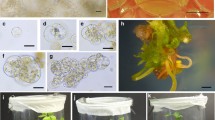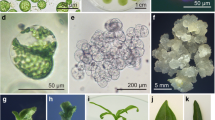Abstract
Mesophyll protoplasts ofSolanum commersonii, a frost tolerant wild species not crossable with the cultivated potato, were fused with either dihaploid or tetraploid S.tuberosum. Protoplasts were aggregated by means of alternating current (AC) or polyethylene glycol (PEG), and electrofused with three direct current (DC) pulses. The treatments with PEG/DC generally resulted in very low heterofusion frequency and protoplast viabiity. On the other hand, AC/DC fusion conditions were optimized by increasing the fusion density of protoplasts and adding CaCl2 to fusion medium. When a density of 4.8 × 105 protoplasts ml−1 was used in the fusion medium containing 0.2 mM Ca++, AC/DC treated protoplasts showed heterofusion frequencies and plating efficiencies of about 10 and 3%, respectively. Fast growing calli from AC/DC fusion experiments were further cultured for regeneration. Fifty-seven plants were regenerated and clonedin vitro as shoot cultures. Compared to parents they showed heterotic vigor and could be identified as hybrids, based on isozyme analysis.
Compendio
Protoplastos mesofílicos deSolatium commersonii, una especie silvestre de papa resistente a las heladas que no admite cruzamiento con las papas cultivadas, fueron fusionados ya sea conS. tuberosum diploide o con tetraploides de esta misma especie. Los protoplastos fueron agregados por medio de corriente alterna (AC) o con glicopolietileno (PEG), y electrofusionados con tres pulsaciones de corriente directa (DC). Los tratamientos con PEG/DC dieron generalmente como resultado muy baja frecuencia de heterofusión y viabilidad de protoplastos. De otro lado, las condiciones de fusión AC/DC fueron optimizadas incrementando la densidad de fusión de los protoplastos y adicionando CaCl2, al medio de fusión. Cuando se utilizó una densidad de 4.8 × 105 protoplastos/cm3 en el medio de fusión conteniendo 0.2 mM Ca++, los protoplastos tratados con AC/DC mostraron frecuencias de heterofusión y eficiencia en platos de alrededor de 10 y 3%, respectivamente. Los callos de rápido crecimiento de los experimentos de fusión AC/DC fueron posteriormente cultivados para su regeneración. Cincuenta y siete plantas fueron regeneradas y se obtuvieron clonesin vitro mediante cultivo de brotes. Comparados con los progenitores ellos mostraron vigor híbrido (heterosis) y pudieron ser identificados como híbridos basándose en el análisis de isoenzimas.
Similar content being viewed by others
Abbreviations
- AC:
-
alternating current
- DC:
-
direct current
- FDA:
-
fluorescein diacetate
- MDH:
-
malate dehydrogenase
- PEG:
-
polyethylene glycol
- POX:
-
peroxidase
Literature Cited
Austin, S., M.A. Baer and J.P. Helgeson. 1985. Transfer of resistance to potato leaf roll virus fromSolanum brevidens intoSolanum tuberosum by somatic fusion. Plant Sci 39:75–82.
Bates, G.W. 1985. Electrical fusion for optimal formation of protoplast heterokaryons inNicotiana. Theor Appl Genet 165:217–224.
Bredemeyer, G.M.M. and H.C.J. Burg. 1986. Peroxidase in suspension cultures ofHaplopappus gracillis. Acta Bot Neerl 35:153–159.
Cardi, T., K.J. Puite and K.S. Ramulu. 1990. Plant regeneration from mesophyll protoplas ts ofSolanum commersonii Dun. Plant Sci 70:215–221.
Cardi, T., F. D’Ambrosio, D. Consoli, K.J. Puite and K.S. Ramulu. 1993. Production of somatic hybrids between frost tolerantSolanum commersonii and S.tuberosum: character ization of hybrid plants. Theor Appl Genet, in press.
Chanabe, C. and G. Alibert. 1990. Somatic hybrid calli produced by protoplast electrofusion of wild and cultivatedHelianthus species.In: Abstr VII Int Cong Plant Tissue and Cell Culture, Amsterdam, June 24–29, 1990, pp. 206 (Abstr.).
Chand, P.K., M.R. Davey, J.B. Power and E.C. Cocking. 1988. An improved procedure for protoplast fusion using polyethylene glycol. J Plant Physiol 133:480–485.
Chapel, M., M.H. Montane, B. Ranty, J. Teissie and G. Alibert. 1986. Viable somatic hybrids are obtained by direct current electrofusion of chemically aggregated plant protoplasts. FEBS Lett 196:79–86.
Chaput, M.H., D. Sihachakr, G. Ducreux, D. Marie and B. Barghi. 1990. Somatic hybrid plants produced by electrofusion between dihaploid potatoes: BF15 (H1), Aminca (H6) and Cardinal (H3). Plant Cell Reports 9:411–414.
Fish, N., A. Karp and M.G.K. Jones. 1988. Production of somatic hybrids by electrofusion. Theor Appl Genet 76:260–266.
Hanneman, R.E., Jr. and J.B. Bamberg. 1986. Inventory of tuber-bearingSolanum species. Wis Agric Exp Stn Bull 533, Madison, 216 pp.
Hawkes, J.G. 1990. The Potato. Evolution, Biodiversity and Genetic Resources. Belhaven Press, London, 259 pp.
Johnston, S.A., R.W. Ruhde, M.K. Ehlenfeldt and R.E. Hanneman, Jr. 1986. Inheritance and microsporogenesis of a synaptic mutant (sy-2) fromSolanum commersonii Dun. Can J Genet Cytol 28:520–524.
Murashige, T. and F. Skoog. 1962. A revised medium for rapid growth and bioassay with tobacco tissue cultures. Physiol Plant 15:473–497.
Novy, R.G. and R.E. Hanneman, Jr. 1991. Hybridization between Gp. Tuberosum hap loids and 1 EBN wild potato species. Am Potato J 68:151–169.
Perronnet, C., C. Denécheau, M. Rideau and J.C. Chénieux. 1988. Electrofusion of chemically-aggregated protoplasts derived from mesophyll tissue and habituated cells ofCatharanthus roseus.In: Progress in Plant Protoplast Research. Puite, K.J., J.J.M. Dons, H.J. Huizing, A.J. Kool, M. Koornneef and S.A. Krens (eds.). Kluwer Academic Publishers, Dordrecht, pp. 271–272.
Puite, K.J., P. van Wikselaar and H. Verhoeven. 1985. Electrofusion, a simple and repro ducible technique in somatic hybridization ofNicotiana plumbaginifolia mutants. Plant Cell Reports 4:274–276.
Puite, K.J., W. Ten Broeke and J. Schaart. 1988. Inhibition of cell wall synthesis improved flow cytometric sorting of potato heterofusions resulting in hybrid plants. Plant Sci 56:61–68.
Ramulu, K.S., H. Verhoeven and P. Dijkhuis. 1988. Mitotic dynamics of micronuclei induced by amiprophos-methyl and prospects for chromosome-mediated gene transfer in plants. Theor Appl Genet 75:575–584.
Uijtewaal, B.A., L.C.J.M. Suurs and E. Jacobsen. 1987. Protoplast fusion of monohaploids (2n=x=12) potato clones: identification of somatic hybrids using malate dehydroge nase as a biochemical marker. Plant Sci 51:277–284.
Vallejos, C.E. 1983. Enzyme activity staining.In: Isozymes in Plant Genetics and Breeding, Part A. Tanksley, S.D. and T.J. Orton (eds.). Elsevier, Amsterdam, pp. 469–516.
Waara, S., H. Tegelstrom, A. Wallin and T. Eriksson. 1989. Somatic hybridization between anther-derived dihaploid clones of potato (Solanum tuberosum L.) and the identifica tion of hybrid plants by isozyme analysis. Theor Appl Genet 77:49–56.
Author information
Authors and Affiliations
Additional information
Contribution no. 106 from Research Centre for Vegetable Breeding.
Rights and permissions
About this article
Cite this article
Cardi, T., Puite, K.J., Ramulu, K.S. et al. Production of somatic hybrids between frost tolerantSolanum commersonii andS. Tuberosum: Protoplast fusion, regeneration and isozyme analysis. American Potato Journal 70, 753–764 (1993). https://doi.org/10.1007/BF02849103
Accepted:
Issue Date:
DOI: https://doi.org/10.1007/BF02849103




